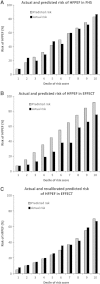Discriminating clinical features of heart failure with preserved vs. reduced ejection fraction in the community
- PMID: 22507977
- PMCID: PMC3530391
- DOI: 10.1093/eurheartj/ehs070
Discriminating clinical features of heart failure with preserved vs. reduced ejection fraction in the community
Abstract
Aims: Heart failure (HF) is a major public health burden worldwide. Of patients presenting with HF, 30-55% have a preserved ejection fraction (HFPEF) rather than a reduced ejection fraction (HFREF). Our objective was to examine discriminating clinical features in new-onset HFPEF vs. HFREF.
Methods and results: Of 712 participants in the Framingham Heart Study (FHS) hospitalized for new-onset HF between 1981 and 2008 (median age 81 years, 53% female), 46% had HFPEF (EF >45%) and 54% had HFREF (EF ≤45%). In multivariable logistic regression, coronary heart disease (CHD), higher heart rate, higher potassium, left bundle branch block, and ischaemic electrocardiographic changes increased the odds of HFREF; female sex and atrial fibrillation increased the odds of HFPEF. In aggregate, these clinical features predicted HF subtype with good discrimination (c-statistic 0.78). Predictors were examined in the Enhanced Feedback for Effective Cardiac Treatment (EFFECT) study. Of 4436 HF patients (median age 75 years, 47% female), 32% had HFPEF and 68% had HFREF. Distinguishing clinical features were consistent between FHS and EFFECT, with comparable discrimination in EFFECT (c-statistic 0.75). In exploratory analyses examining the traits of the intermediate EF group (EF 35-55%), CHD predisposed to a decrease in EF, whereas other clinical traits showed an overlapping spectrum between HFPEF and HFREF.
Conclusion: Multiple clinical characteristics at the time of initial HF presentation differed in participants with HFPEF vs. HFREF. While CHD was clearly associated with a lower EF, overlapping characteristics were observed in the middle of the left ventricular EF range spectrum.
Figures


Comment in
-
Phenotypic and pathophysiological heterogeneity in heart failure with preserved ejection fraction.Eur Heart J. 2012 Jul;33(14):1716-7. doi: 10.1093/eurheartj/ehs124. Epub 2012 Jun 22. Eur Heart J. 2012. PMID: 22730487 No abstract available.
Similar articles
-
Clinical characteristics of hospitalized heart failure patients with preserved, mid-range, and reduced ejection fractions in Japan.ESC Heart Fail. 2019 Jun;6(3):475-486. doi: 10.1002/ehf2.12418. Epub 2019 Mar 3. ESC Heart Fail. 2019. PMID: 30829002 Free PMC article.
-
Epidemiology and one-year outcomes in patients with chronic heart failure and preserved, mid-range and reduced ejection fraction: an analysis of the ESC Heart Failure Long-Term Registry.Eur J Heart Fail. 2017 Dec;19(12):1574-1585. doi: 10.1002/ejhf.813. Epub 2017 Apr 6. Eur J Heart Fail. 2017. PMID: 28386917
-
Predictors of new-onset heart failure: differences in preserved versus reduced ejection fraction.Circ Heart Fail. 2013 Mar;6(2):279-86. doi: 10.1161/CIRCHEARTFAILURE.112.972828. Epub 2012 Dec 27. Circ Heart Fail. 2013. PMID: 23271790 Free PMC article.
-
Sudden death in heart failure with preserved ejection fraction and beyond: an elusive target.Heart Fail Rev. 2019 Nov;24(6):847-866. doi: 10.1007/s10741-019-09804-2. Heart Fail Rev. 2019. PMID: 31147814 Review.
-
Heart failure with preserved ejection fraction: current understandings and challenges.Curr Cardiol Rep. 2014 Jul;16(7):501. doi: 10.1007/s11886-014-0501-8. Curr Cardiol Rep. 2014. PMID: 24893938 Review.
Cited by
-
Central cardiac limit to aerobic capacity in patients with exertional pulmonary venous hypertension: implications for heart failure with preserved ejection fraction.Circ Heart Fail. 2015 Mar;8(2):278-85. doi: 10.1161/CIRCHEARTFAILURE.114.001551. Epub 2014 Dec 30. Circ Heart Fail. 2015. PMID: 25550438 Free PMC article.
-
Prognostic significance of residual functional mitral regurgitation in hospitalized heart failure patients with chronic atrial fibrillation and preserved ejection fraction after medical therapies.J Echocardiogr. 2019 Dec;17(4):197-205. doi: 10.1007/s12574-018-0412-6. Epub 2018 Dec 19. J Echocardiogr. 2019. PMID: 30569445
-
Coronary Artery Disease and Heart Failure With Preserved Ejection Fraction: The ARIC Study.J Am Heart Assoc. 2022 Sep 6;11(17):e021660. doi: 10.1161/JAHA.121.021660. Epub 2022 Aug 24. J Am Heart Assoc. 2022. PMID: 36000416 Free PMC article.
-
Comparison of the Relation of Carotid Intima-Media Thickness With Incident Heart Failure With Reduced Versus Preserved Ejection Fraction (from the Multi-Ethnic Study of Atherosclerosis [MESA]).Am J Cardiol. 2021 Jun 1;148:102-109. doi: 10.1016/j.amjcard.2021.02.020. Epub 2021 Mar 3. Am J Cardiol. 2021. PMID: 33667446 Free PMC article.
-
Modification of the Association of B-Type Natriuretic Peptides With Mortality and Hospitalization Outcomes by Sex.JACC Adv. 2025 Aug;4(8):101999. doi: 10.1016/j.jacadv.2025.101999. Epub 2025 Jul 24. JACC Adv. 2025. PMID: 40712268 Free PMC article.
References
-
- Lloyd-Jones DM, Larson MG, Leip EP, Beiser A, D'Agostino RB, Kannel WB, Murabito JM, Vasan RS, Benjamin EJ, Levy D. Lifetime risk for developing congestive heart failure: the Framingham Heart Study. Circulation. 2002;106:3068–3072. - PubMed
-
- Cleland JG, Tendera M, Adamus J, Freemantle N, Polonski L, Taylor J. The perindopril in elderly people with chronic heart failure study. Eur Heart J. 2006;27:2338–2345. - PubMed
-
- Hogg K, Swedberg K, McMurray J. Heart failure with preserved left ventricular systolic function. J Am Coll Cardiol. 2004;43:317–327. - PubMed
-
- Owan TE, Hodge DO, Herges RM, Jacobsen SJ, Roger VL, Redfield MM. Trends in prevalence and outcome of heart failure with preserved ejection fraction. N Engl J Med. 2006;355:251–259. - PubMed
Publication types
MeSH terms
Substances
Grants and funding
LinkOut - more resources
Full Text Sources
Medical
Research Materials
Miscellaneous

